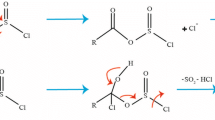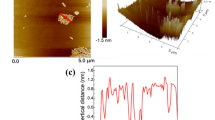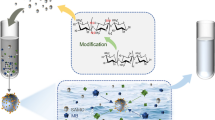Abstract
In the present study, we have synthesized a nano-adsorbent of carboxymethyl cellulose; carboxymethyl cellulose/graphitic-carbon nitride/zinc oxide (CMC/g-C3N4/ZnO) by sol–gel technique. It has been utilized for the adsorptional elimination of methyl violet (MV) from aqueous solution. Maximum surface area as determined from the BET analyses is 9.214 m2/g. XRD analysis confirmed the semi-crystalline nature of the nano-adsorbent. Presence of desired functionalities on the surface of nano-adsorbent, CMC/g-C3N4/ZnO offered maximum interactions with the MV molecules. Isotherm studies generalized the monolayer adsorption of MV molecules with maximum adsorption capacity of 96.43 mg/g. Solution pH affected the adsorption rate to large extent and maximum occurred at pH 8. Pseudo-second order model better explained the adsorption process that determines the chemical interactions between methyl violet and CMC/g-C3N4/ZnO.
Graphic abstract









Similar content being viewed by others
References
Allen S, Mckay G, Porter JF (2004) Adsorption isotherm models for basic dye adsorption by peat in single and binary component systems. J Colloid Interf Sci 280(2):322–333
Ayawei N, Ebelegi AN, Wankasi D (2017) Modelling and interpretation of adsorption isotherms. J Chem 2017:11
Azizian S, Haerifar M, Bashiri H (2009) Adsorption of methyl violet onto granular activated carbon: equilibrium, kinetics and modeling. Chem Eng J 146(1):36–41
Biswal D, Singh R (2004) Characterisation of carboxymethyl cellulose and polyacrylamide graft copolymer. Carbohydr Polym 57(4):379–387
Bono A, Ying P, Yan F, Muei C, Sarbatly R, Krishnaiah D (2009) Synthesis and characterization of carboxymethyl cellulose from palm kernel cake. Adv Nat Appl Sci 3(1):5–12
Cai X, He J, Chen L, Chen K, Li Y, Zhang K et al (2017) A 2D-g-C3N4 nanosheet as an eco-friendly adsorbent for various environmental pollutants in water. Chemosphere 171:192–201
Chen S, Zhang J, Zhang C, Yue Q, Li Y, Li C (2010) Equilibrium and kinetic studies of methyl orange and methyl violet adsorption on activated carbon derived from Phragmites australis. Desalination 252(1–3):149–156
Cho E, Tahir MN, Kim H, Yu J-H, Jung S (2015) Removal of methyl violet dye by adsorption onto N-benzyltriazole derivatized dextran. RSC Adv 5(43):34327–34334
Dai H, Huang Y, Zhang Y, Zhang H, Huang H (2019a) Green and facile fabrication of pineapple peel cellulose/magnetic diatomite hydrogels in ionic liquid for methylene blue adsorption. Cellulose 26(6):3825–3844. https://doi.org/10.1007/s10570-019-02283-6
Dai J, Tian Q, Sun Q, Wei W, Zhuang J, Liu M et al (2019b) TiO2-alginate composite aerogels as novel oil/water separation and wastewater remediation filters. Comp Part B: Eng 160:480–487. https://doi.org/10.1016/j.compositesb.2018.12.097
Das AM, Ali AA, Hazarika MP (2014) Synthesis and characterization of cellulose acetate from rice husk: eco-friendly condition. Carbohydr Polym 112:342–349. https://doi.org/10.1016/j.carbpol.2014.06.006
Dhiman P, Chand J, Kumar A, Kotnala RK, Batoo KM, Singh M (2013) Synthesis and characterization of novel Fe@ZnO nanosystem. J Alloys Compd 578:235–241. https://doi.org/10.1016/j.jallcom.2013.05.015
Doğan M, Alkan M (2003) Adsorption kinetics of methyl violet onto perlite. Chemosphere 50(4):517–528
El-Latif MA, Ibrahim AM, El-Kady M (2010) Adsorption equilibrium, kinetics and thermodynamics of methylene blue from aqueous solutions using biopolymer oak sawdust composite. J Am Sci 6(6):267–283
Forgiarini E, de Souza AAU (2007) Toxicity of textile dyes and their degradation by the enzyme horseradish peroxidase (HRP). J Hazard Mater 147(3):1073–1078
Ghorai S, Sarkar A, Raoufi M, Panda AB, Schönherr H, Pal S (2014) Enhanced removal of methylene blue and methyl violet dyes from aqueous solution using a nanocomposite of hydrolyzed polyacrylamide grafted xanthan gum and incorporated nanosilica. ACS Appl Mater Int 6(7):4766–4777
Goswami M, Das AM (2019) Synthesis and characterization of a biodegradable Cellulose acetate-montmorillonite composite for effective adsorption of Eosin Y. Carbohydr Polym 206:863–872. https://doi.org/10.1016/j.carbpol.2018.11.040
Gupta VK, Saleh TA, Pathania D, Rathore BS, Sharma G (2015) A cellulose acetate based nanocomposite for photocatalytic degradation of methylene blue dye under solar light. Ionics 21(6):1787–1793
Joshi G, Naithani S, Varshney V, Bisht SS, Rana V, Gupta P (2015) Synthesis and characterization of carboxymethyl cellulose from office waste paper: a greener approach towards waste management. Waste Manage 38:33–40
Kalia S, Thakur K, Kumar A, Celli A (2014) Laccase-assisted surface functionalization of lignocellulosics. J Mol Catal B Enzym 102:48–58. https://doi.org/10.1016/j.molcatb.2014.01.014
Kannan N, Sundaram MM (2001) Kinetics and mechanism of removal of methylene blue by adsorption on various carbons—a comparative study. Dyes Pigments 51(1):25–40
Kim HG, Kwac LK, Kim Y-S, Shin HK, Rhee K-Y (2018) Synthesis and characterization of eco-friendly carboxymethyl cellulose based carbon foam using electron beam irradiation. Compos Part B: Eng 151:154–160. https://doi.org/10.1016/j.compositesb.2018.06.013
Kołodziejczak-Radzimska A, Jesionowski T (2014) Zinc oxide—from synthesis to application: a review. Materials 7(4):2833–2881
Kooh MRR, Dahri MK, Lim LB (2017) Removal of the methyl violet 2B dye from aqueous solution using sustainable adsorbent Artocarpus odoratissimus stem axis. Appl Water Sci 7(7):3573–3581
Kumar A, Kumar A, Sharma G, Naushad M, Veses RC, Ghfar AA et al (2017) Solar-driven photodegradation of 17-β-estradiol and ciprofloxacin from waste water and CO2 conversion using sustainable coal-char/polymeric-g-C3N4/RGO metal-free nano-hybrids. New J Chem 41(18):10208–10224. https://doi.org/10.1039/c7nj01580a
Kumar A, Kumar A, Sharma G, Ala’a H, Naushad M, Ghfar AA et al (2018a) Biochar-templated g-C3N4/Bi2O2CO3/CoFe2O4 nano-assembly for visible and solar assisted photo-degradation of paraquat, nitrophenol reduction and CO2 conversion. Chem Eng J 339:393–410
Kumar A, Kumari A, Sharma G, Naushad M, Ahamad T, Stadler FJ (2018b) Utilizing recycled LiFePO4 from batteries in combination with B@C3N4 and CuFe2O4 as sustainable nano-junctions for high performance degradation of atenolol. Chemosphere 209:457–469. https://doi.org/10.1016/j.chemosphere.2018.06.117
Kumar A, Rana A, Sharma G, Naushad M, Al-Muhtaseb A, Guo AAHC et al (2018c) High-performance photocatalytic hydrogen production and degradation of levofloxacin by wide spectrum-responsive Ag/Fe3O4 bridged SrTiO3/g-C3N4 plasmonic nanojunctions: joint Effect of Ag and Fe3O4. ACS Appl Mater Interface 10(47):40474–40490
Li H, Liu J, Hou W, Du N, Zhang R, Tao X (2014a) Synthesis and characterization of g-C3N4/Bi2MoO6 heterojunctions with enhanced visible light photocatalytic activity. Appl Catal B: Environ 160:89–97
Li X, Li M, Yang J, Li X, Hu T, Wang J et al (2014b) Synergistic effect of efficient adsorption g-C3N4/ZnO composite for photocatalytic property. J Phys Chem Solids 75(3):441–446
Liu R, Zhang B, Mei D, Zhang H, Liu J (2011) Adsorption of methyl violet from aqueous solution by halloysite nanotubes. Desalination 268(1–3):111–116
Ma Y, Qi P, Ju J, Wang Q, Hao L, Wang R et al (2019) Gelatin/alginate composite nanofiber membranes for effective and even adsorption of cationic dyes. Compos Part B: Eng 162:671–677. https://doi.org/10.1016/j.compositesb.2019.01.048
Mahini R, Esmaeili H, Foroutan R (2018) Adsorption of methyl violet from aqueous solution using brown algae Padina sanctae-crucis. Turk J Biochem 43:623–631
Mall ID, Srivastava VC, Agarwal NK (2006) Removal of Orange-G and Methyl Violet dyes by adsorption onto bagasse fly ash—kinetic study and equilibrium isotherm analyses. Dyes Pigmens 69(3):210–223
Mittal H, Kumar V, Ray SS (2016) Adsorption of methyl violet from aqueous solution using gum xanthan/Fe3O4 based nanocomposite hydrogel. Int J Biolog Macromole 89:1–11
Moezzi A, McDonagh AM, Cortie MB (2012) Zinc oxide particles: synthesis, properties and applications. Chem Eng J 185:1–22
Moussavi G, Mahmoudi M (2009) Removal of azo and anthraquinone reactive dyes from industrial wastewaters using MgO nanoparticles. J Hazard Mater 168(2–3):806–812
Naushad M (2014) Surfactant assisted nano-composite cation exchanger: development, characterization and applications for the removal of toxic Pb2+ from aqueous medium. Chem Eng J 235:100–108
Naushad M, Ahamad T, Sharma G, Ala’a H, Albadarin AB, Alam MM et al (2016) Synthesis and characterization of a new starch/SnO2 nanocomposite for efficient adsorption of toxic Hg2+ metal ion. Chem Eng J 300:306–316
Naushad M, Sharma G, Kumar A, Sharma S, Ghfar AA, Bhatnagar A et al (2018) Efficient removal of toxic phosphate anions from aqueous environment using pectin based quaternary amino anion exchanger. Int J Bio Macromol 106:1–10
Naushad M, Sharma G, ALothman ZA (2019) Photodegradation of toxic dye using Gum Arabic-crosslinked-poly (acrylamide)/Ni(OH)2/FeOOH nanocomposites hydrogel. J Clean Prod 241:118263
Ozgur U, Hofstetter D, Morkoc H (2010) ZnO devices and applications: a review of current status and future prospects. Proc IEEE 98(7):1255–1268
Özgür Ü, Alivov YI, Liu C, Teke A, Reshchikov M, Doğan S et al (2005) A comprehensive review of ZnO materials and devices. J Appl Phys 98(4):11
Petroudy SRD, Ranjbar J, Rasooly Garmaroody E (2018) Eco-friendly superabsorbent polymers based on carboxymethyl cellulose strengthened by TEMPO-mediated oxidation wheat straw cellulose nanofiber. Carbohydr Polym 197:565–575. https://doi.org/10.1016/j.carbpol.2018.06.008
Phatai P, Futalan CM (2016) Removal of methyl violet dye by adsorption onto mesoporous mixed oxides of cerium and aluminum. Desalin Water Tream 57(19):8884–8893
Raza W, Haque M, Muneer M (2014) Synthesis of visible light driven ZnO: characterization and photocatalytic performance. Appl Sur Sci 322:215–224
Rusu AG, Popa MI, Lisa G, Vereştiuc L (2015) Thermal behavior of hydrophobically modified hydrogels using TGA/FTIR/MS analysis technique. Thermochim Acta 613:28–40
Santoso SP, Kurniawan A, Soetaredjo FE, Cheng K-C, Putro JN, Ismadji S et al (2019) Eco-friendly cellulose–bentonite porous composite hydrogels for adsorptive removal of azo dye and soilless culture. Cellulose 26(5):3339–3358. https://doi.org/10.1007/s10570-019-02314-2
Sharma G, Naushad M, Pathania D, Mittal A, El-Desoky G (2015) Modification of Hibiscus cannabinus fiber by graft copolymerization: application for dye removal. Desalin Water Treat 54(11):3114–3121
Sharma G, Kumar A, Chauhan C, Okram A, Sharma S, Pathania D et al (2017a) Pectin-crosslinked-guar gum/SPION nanocomposite hydrogel for adsorption of m-cresol and o-chlorophenol. Sustain Chem Pharm 6:96–106
Sharma G, Naushad M, Ala’a A, Kumar A, Khan MR, Kalia S et al (2017b) Fabrication and characterization of chitosan-crosslinked-poly (alginic acid) nanohydrogel for adsorptive removal of Cr(VI) metal ion from aqueous medium. Int J Bio Macromol 95:484–493
Sharma G, Naushad M, Kumar A, Rana S, Sharma S, Bhatnagar A et al (2017c) Efficient removal of coomassie brilliant blue R-250 dye using starch/poly (alginic acid-cl-acrylamide) nanohydrogel. Process Saf Environ 109:301–310
Sharma G, Kumar A, Devi K, Sharma S, Naushad M, Ghfar AA et al (2018a) Guar gum-crosslinked-Soya lecithin nanohydrogel sheets as effective adsorbent for the removal of thiophanate methyl fungicide. Int J Bio Macromol 114:295–305
Sharma G, Kumar A, Naushad M, García-Peñas A, Ala’a H, Ghfar AA et al (2018b) Fabrication and characterization of Gum arabic-cl-poly (acrylamide) nanohydrogel for effective adsorption of crystal violet dye. Carbohydr Polym 202:444–453
Sharma G, Kumar A, Naushad M, Kumar A, Al-Muhtaseb A, Dhiman AHP et al (2018c) Photoremediation of toxic dye from aqueous environment using monometallic and bimetallic quantum dots based nanocomposites. J Clean Prod 172:2919–2930. https://doi.org/10.1016/j.jclepro.2017.11.122
Sharma G, Sharma S, Kumar A, Ala’a H, Naushad M, Ghfar AA et al (2018d) Guar gum and its composites as potential materials for diverse applications: a review. Carbohydr Polym 199:534–545
Sharma G, Sharma S, Kumar A, Naushad M, Du B, Ahamad T et al (2019) Honeycomb structured activated carbon synthesized from Pinus roxburghii cone as effective bioadsorbent for toxic malachite green dye. J Water Process Eng 32:100931
Sirelkhatim A, Mahmud S, Seeni A, Kaus NHM, Ann LC, Bakhori SKM et al (2015) Review on zinc oxide nanoparticles: antibacterial activity and toxicity mechanism. Nano-Micro Lett 7(3):219–242
Subramanyam B, Ashutosh D (2012) Adsorption isotherm modeling of phenol onto natural soils–applicability of various isotherm models. Int J Environ Res 6(1):265–276
Tahir N, Bhatti HN, Iqbal M, Noreen S (2017) Biopolymers composites with peanut hull waste biomass and application for Crystal Violet adsorption. Int J Bio Macromol 94:210–220
Tan KB, Vakili M, Horri BA, Poh PE, Abdullah AZ, Salamatinia B (2015) Adsorption of dyes by nanomaterials: recent developments and adsorption mechanisms. Sep Purif Technol 150:229–242
Tran HN, Wang Y-F, You S-J, Chao H-P (2017a) Insights into the mechanism of cationic dye adsorption on activated charcoal: the importance of π − π interactions. Process Saf Environ 107:168–180
Tran HN, You S-J, Hosseini-Bandegharaei A, Chao H-P (2017b) Mistakes and inconsistencies regarding adsorption of contaminants from aqueous solutions: a critical review. Water Res 120:88–116
Van Vlierberghe S, Dubruel P, Schacht E (2011) Biopolymer-based hydrogels as scaffolds for tissue engineering applications: a review. Biomacromol 12(5):1387–1408
Wang S, Li D, Sun C, Yang S, Guan Y, He H (2014) Synthesis and characterization of g-C3N4/Ag3VO4 composites with significantly enhanced visible-light photocatalytic activity for triphenylmethane dye degradation. Appl Catal B: Environ 144:885–892
Wang J, Chen R, Xiang L, Komarneni S (2018) Synthesis, properties and applications of ZnO nanomaterials with oxygen vacancies: a review. Ceram Int 44(7):7357–7377
Wen J, Xie J, Chen X, Li X (2017) A review on g-C3N4-based photocatalysts. Appl Surf Sci 391:72–123
Xu R-K, Xiao S-C, Yuan J-H, Zhao A-Z (2011) Adsorption of methyl violet from aqueous solutions by the biochars derived from crop residues. Bioresour Technol 102(22):10293–10298
Yang F, Li G, He Y-G, Ren F-X, Wang G-X (2009) Synthesis, characterization, and applied properties of carboxymethyl cellulose and polyacrylamide graft copolymer. Carbohydr Polym 78(1):95–99
Zhang G, Yi L, Deng H, Sun P (2014) Dyes adsorption using a synthetic carboxymethyl cellulose-acrylic acid adsorbent. J Environ Sci 26(5):1203–1211
Acknowledgments
The authors extend their appreciation to the Deanship of Scientific Research at King Saud University for funding this work through research group No. RG-1436-034.
Author information
Authors and Affiliations
Corresponding author
Ethics declarations
Conflict of interest
The author declares no conflict of interest.
Additional information
Publisher's Note
Springer Nature remains neutral with regard to jurisdictional claims in published maps and institutional affiliations.
Electronic supplementary material
Below is the link to the electronic supplementary material.
Rights and permissions
About this article
Cite this article
Sharma, G., Kumar, A., Sharma, S. et al. Carboxymethyl cellulose structured nano-adsorbent for removal of methyl violet from aqueous solution: isotherm and kinetic analyses. Cellulose 27, 3677–3691 (2020). https://doi.org/10.1007/s10570-020-02989-y
Received:
Accepted:
Published:
Issue Date:
DOI: https://doi.org/10.1007/s10570-020-02989-y




